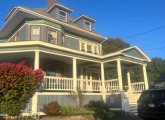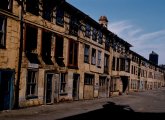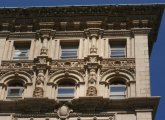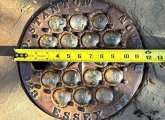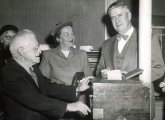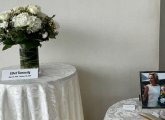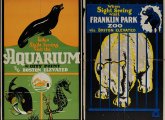The staff at the Boston Landmarks Commission this week recommended that the Fox House on Metropolitan Avenue at Maynard Street in Roslindale be designated an official city landmark for both its architectural history and qualities and the lives of some of its early owners. Read more.
The JFK Library Foundation says the Dorchester library and museum will re-open to the public tomorrow. In a separate statement e-mailed to reporters, it adds: Read more.
No, not R, but T. T Wharf used to extend out from what is now Christopher Columbus Park, as an extension to Long Wharf (which itself used to be a half mile long). Read more.
The Boston Landmarks Commission has officially designated City Hall as a landmark building. Read more.
The Boston Landmarks Commission recently designated the Jewelers' Building at Washington and Bromfield streets as the city's newest official landmark. Read more.
John W. Mackey considers the meaning of the map Osgood Carleton created in 1795 for the town of Boston's selectmen that measures seven feet by six and a half feet. Read more.
A concerned resident files a 311 complaint about a small busted manhole cover in front of one residence on Pembroke Street in the South End: Read more.
In 1978, Carter visited Massachusetts to campaign for Democratic candidates - including Michael Dukakis, who lost his re-election bid to Ed King.
The 39th president and Nobel Peace Prize recipient died today at 100. Here are accounts and transcripts from some of his visits to the Boston area: Read more.
J.L. Bell, who studies and writes about pre-Revolutionary New England, discusses a Louisiana law (currently stayed during a lawsuit) that requires public schools to display a copy of the Ten Commandments - and a "context statement" that refers to the 17th-century New England Primer, a reader for young students, as proof Christianity has always been a part of American public education. Read more.
Fishwrap recounts the story of Axel Andre Bjorklund, a Swedish immigrant who wanted to do something for poor kids at Christmas time and so set up a free hot-dog stand at Blackstone and Hanover streets in the North End in 1921. Read more.
J.L. Bell introduces us to the cherubs of Old North Church - and alerts us to a talk next Wednesday by the conservator who is leading the effort to restore all those cute little cheeks you'll just want to pinch, only you shouldn't.
Shortly before 2:30 a.m. on Nov. 15, 1942 - a fire broke out in the ceiling above the first-floor kitchen of Luongo's Tap on Henry Street in East Boston - just 2 1/2 hours after some 200 couples had gathered for some dancing in the place's second-floor dance hall. Boston firefighters responded to what grew into a three-alarm blaze in the five-story brick building. Read more.
Boston College's Burns Library posted this photo of US Rep. Tip O'Neill voting in Cambridge in 1955.
The Dorchester Reporter reports several hundred people gathered Sunday at the Old Dorchester North Burial Ground in Uphams Corner to learn more about the historic cemetery, one of the oldest in Boston, but rarely open to the public.
Aline Boucher Kaplan photographed the flowers, photo and condolences book the JFK Library and Museum put out to honor Ethel Kennedy, Robert Kennedy's wife and a human-rights activist, who died today at 96.
The Boston Public Improvement Commission today approved renaming the road that bisects the Arnold Arboretum as Flora Way, to honor a Black woman enslaved by a nearby landowner in the 1700s, the Rename Bussey Street group of Roslindale and Jamaica Plain residents reports. Read more.
Before the MBTA, before even Charlie got stuck on the MTA, there was the Boston Elevated Railway Co., the El, a private company formed out of streetcar, bus and, yes, underground subways in the Boston area. Read more.
- Page 1
- next ›

